telegraphic codes and message practice
scanned code directory
Codes of Edmund Peycke, 1900 – 1918
This long, scroll-down page is part of a redistribution (and expansion) of content in my scanned code directory project. It provides comments to Peycke codes, and links to the three codes (1903, 1908 and 1918) for which scans are currently (December 2012) available. It also provides some context for Peycke’s codes: biographical, some information about his non-code business, and about his children. This is a work in progress.
1900 The Economy Telegraphic Cipher Code
1903 The revised economy telegraphic and cable cipher code
1904 Peycke’s Abbreviation Key. No. 3.
1905 Peycke’s Grain Code
1906 Peycke’s telegraphic and cable short-hand cipher code
1908 The Modern Economy Telegraphic and Cable Cipher Code
1918 Peycke’s New Ekonomik Telegraphic Cipher Code
patents
Peycke brand fruit crate labels
Frieda Peycke, composer-interpreter (1885-1964)
Armand H. Peycke, engineer (1886-1968)
biographical note
Edmund Peycke was born in Germany in May 1853, came to the United States in 1868, and was naturalized in 1877. His wife was Christina Sturne (or Sturnée, born 1856 in Germany, came to the U.S. in 1881).
Edmund is listed with two other Peyckes (his brothers?) in an Omaha, Nebraska business directory for 1889: Peycke Bros Co., Ernest Peycke (president), Edmund Peycke (vice-president), Julius Peycke (treasurer), and Eduard J H Wohlers (secretary). The business (located at 1102, 1104 and 1106 Howard), was engaged in general commission, produce, candy manufacturers, fruit, cigar dealers and oyster dealers. An 1892 business directory for Omaha lists Ernest and Julius, but omits Edmund, from the company’s management (Pen and sunlight sketches of Omaha and environs, here). (It also describes the Peycke Candy Company, in the encomiastic style common to such volumes.)
At the time of the 1900 Census, Edmund Peycke is living in Chicago with his wife and two children, both born in Nebraska — Frieda (b1885) and Armand (b1886). In that same year, the Economy Telegraphic Cipher Code is published by Peycke & Fry (located at 34 Clark Street). For reasons given below, it is probable that it was preceded by at least one private edition.
Peycke is listed in the 1920 census, living with his daughter Frieda at 3rd Avenue in Los Angeles. I do not (yet) find date of death, brother Julius was 1860-1905 (died in Omaha).
Edmund Peycke may have devoted more and more of his time to his codes, suggesting a proclivity to systems, classification, language. His son Armand was an engineer, whose mechanical design and drawing services are advertised in the 1905 Grain Code. His daughter Frieda, with whom he lived for at least some of his time in Los Angeles, was a composer-interpreter (meaning, she composed scores for piano accompaniment of poetic recitations — she performed and recited, and published her compositions).
The Peycke codes, overview
The Peycke codes were specialized and evolved as the fruit/produce brokerage business expanded, entered into new areas (e.g., avocados), and saw changes in distribution (e.g., increasing availability of refrigerated box cars). When 5L codes came into use, Peycke adopted that format. He patented a marginal index system (tabs, sectional tables of contents), and developed (but did not patent) an abbreviation
system that made it possible to fit more facets of a single topic (e.g., dried apples) on a single page. There was nothing original about that abbreviation system, however.
| 1900 | The economy telegraphic cipher code | Chicago, Peycke & Fry |
LC HE7677.F9 P5 have not examined |
211 p. 18 cm.
The Economy Code is later described (in the New Ekonomik Telegraphic Cipher Code (1918) as having been published in 1897 in an edition of 120 pages. LC shows it for 1900, with 211 pages. I suspect that this 1900 publication is an expansion of a code published privately in 1897.
It is only a little more than half as long as its 1903 successor.
| 1903 | The revised economy telegraphic and cable cipher code adapted to the use of buyers, sellers, brokers, shippers and receivers of green and dried fruit and produce. | brokerage, fruit and produce | Edmund Peycke Los Angeles and Kansas City | google (NYPL) |
Edmund Peycke (c), Los Angeles and Kansas City, 1903; printed by Lechtman Printing, Kansas City, 1903. This copy stamped Amercian [sic] Code Company
original at NYPL
v-xii, 1-344.
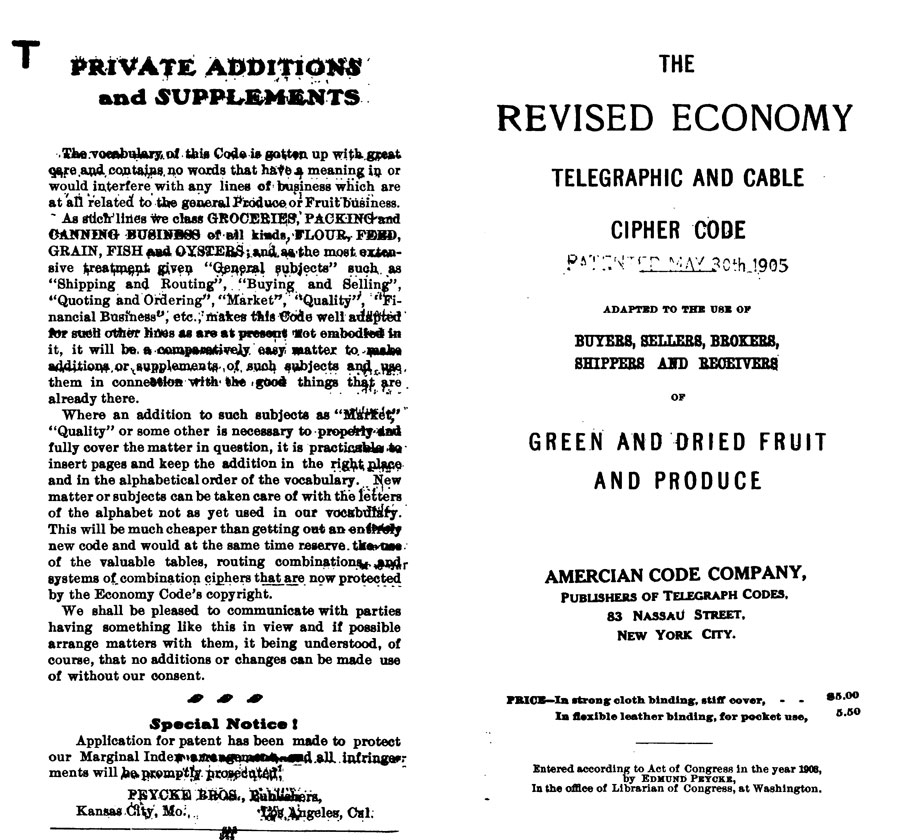 |
|
| last page at left, title at right; cropped, some show-through removed. | |
The patent, which was granted after the code was published, concerns the marginal (tab) index. That would be US791,209 (1905), Marginal and sub index for telegraphic cipher codes (CCL 283/36 for the lateral marginal projections.
The code proper was protected by patent.
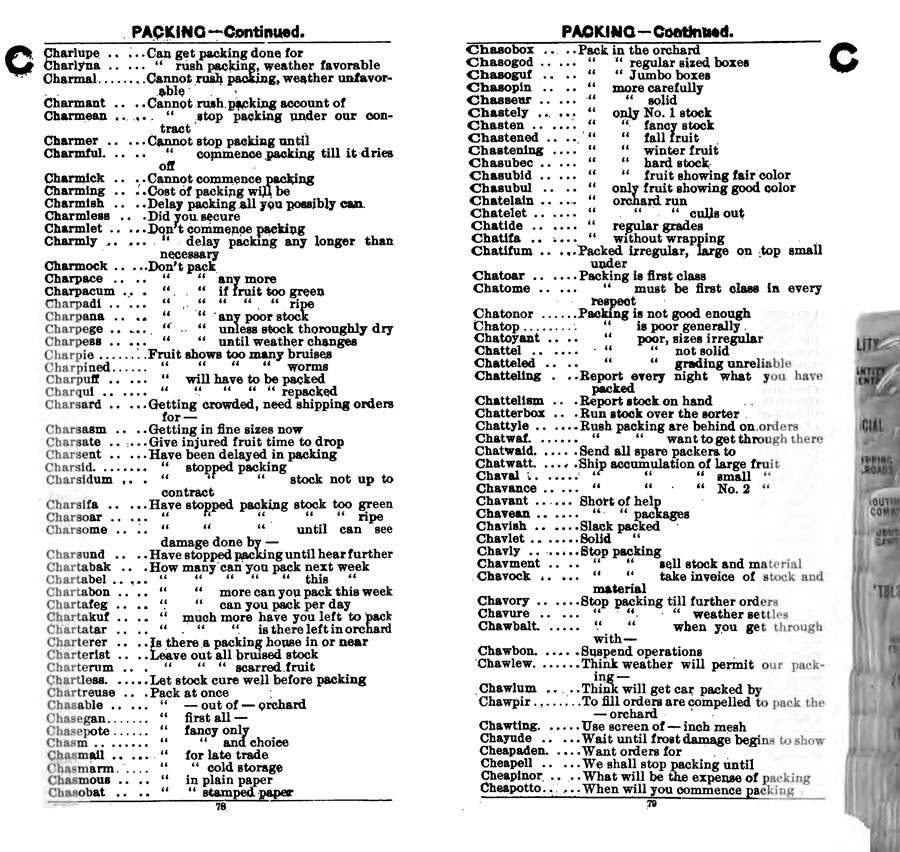 |
|
| pp78-79, packing phrases. showing tabs along recto side. |
|
Quite detailed packing phrases.
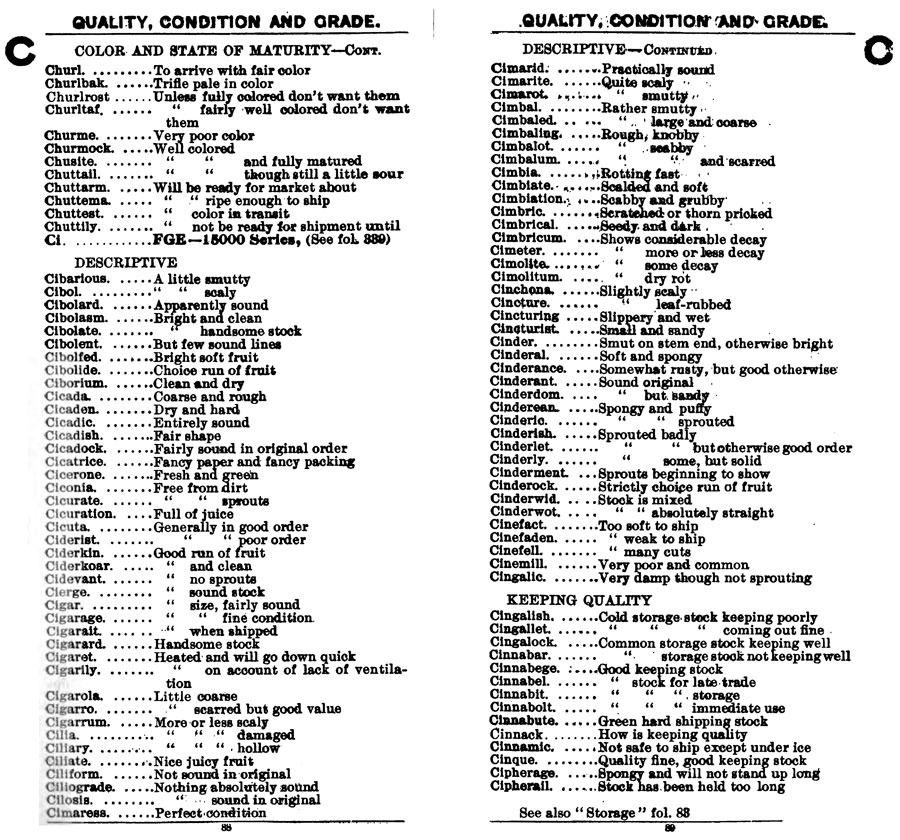 |
|
| pp88-89, quality, condition and grade. Showing text block only, cropped from google scans, with tabs along recto side omitted here (poor original). |
|
Codewords are 10L or shorter (later Peycke codes would adopt the 5L norm). A remarkable passage in the Preface concerns the nature of those code words —
The Book before you has a Vocabulary of Code words numbering over 40,000. There is not that number of words in
Webster’s Unabridged
that can be used for this purpose, for a Code-word
must have no meaning in the particular line of business in which the Code is used, nor should words be used the spelling of which differs in but one letter. Furthermore, all compound words, as well as words consisting of more than ten letters are barred by recent ruling of the Telegraph Companies. In order to follow thee rules, as we have done, not only made-up
words (pronounceable groups of letters) have to be used, but also a great many that have the appearance of being badly misspelt
dictionary words. Use the words just as they are, use them with the above suggestions in mind and you will find the Revised Economy Code more satisfactory than any other Code that has heretofore been on the market. ¶ We have kept away from foreign languages,
from which so many words have of late years been used in Cipher Codes, most of them being harder to copy and spell, and a great deal worse to telegraph than the worst of our made-up words.
Apparently pasted on to obverse of additional pages 0a and 0b (between xii and p 1), is this typewritten notice :
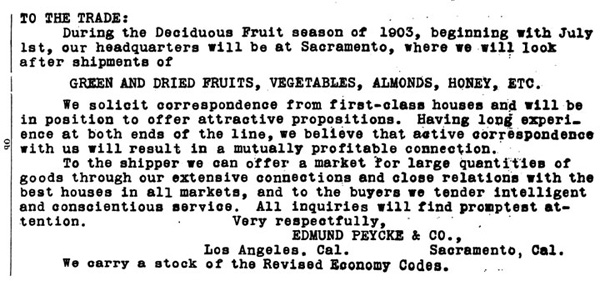 |
|
| caption | |
Features: index, thorough phraseology, much of it in tabular form.
| 1904 | Peycke’s Abbreviation Key. No. 3. Adaptable to all codes up to 308,000 cipher words. | 53pp, fol. Peycke Bros. Los Angeles, Cal. | BL General Reference Collection 8756.e.21. |
have not seen.
| 1905 | Peycke’s Grain Code adapted to the use of buyers, sellers, brokers, shippers and receivers of grain and feed stuffs, hay and flour / cereal products and field seeds arranged under Peycke’s abbreviation system | grain brokerage | compiled and published by Peycke Bros. cipher code experts Los Angeles, Cal. | private collection |
4 1/2 x 7 3/4 inches, 218 pages.
copyright Edmund Peycke and Julius Peycke.
I have dismantled my own copy of this code, to better show it here. It was printed in nine signatures (of differing thicknesses), which were then stapled not through the fold, but straight across, front to back. All but the first signature are marked: 2, 3, 4, 5, 5 1/2, 6, 7 and 8. The last three signatures are given over to a Directory No. 1
(May 1905) of Parties Using Peycke’s Grain Code.
The bottom of the rear endpaper contains this:
Monotyped and printed by The Times Mirror Printing and Binding House, Los Angeles, Cal.
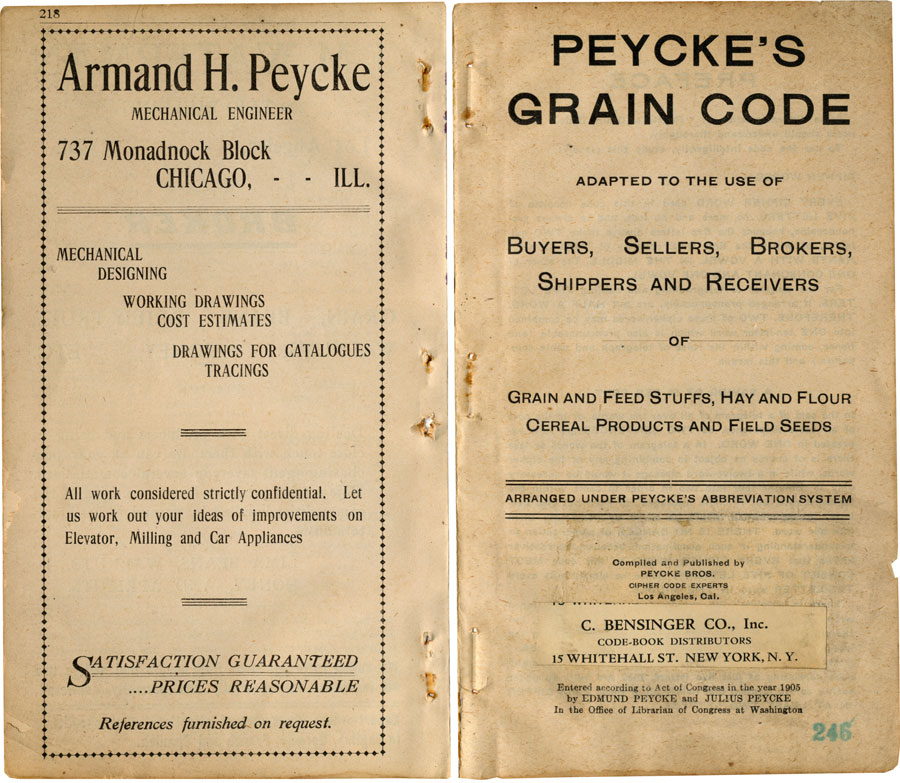 |
|
| title page (right) and last printed page (left). | |
text
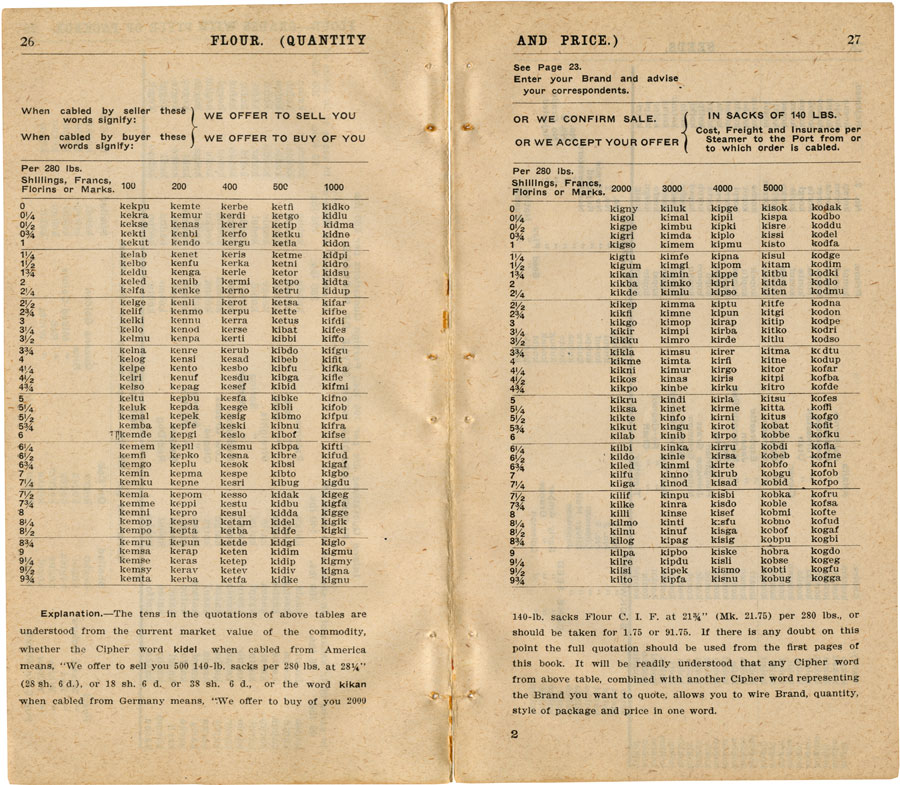 |
|
| Flour: quantity and price (offers to sell or buy, or confirmation/acceptance of sale/offer) | |
Shown above is a standard w-y table, with if/then conditions at top providing a third orientation.
Note also the use of partical
prices (see explanation
) in which users understand the tens
based on their knowledge of the current market (what is and is not possible). One of these 5L ciphers, combined with another 5L cipher signifying a brand, would have been counted as a single 10L codeword.
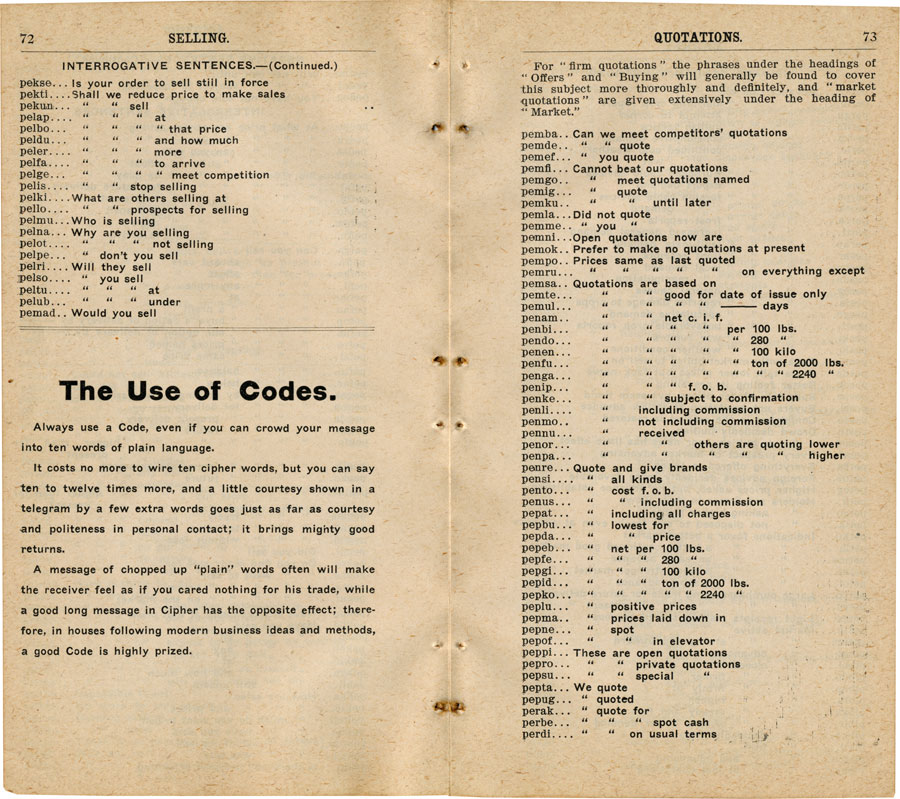 |
|
| standard selling and quotation phrases. | |
Note above the rationale given for using code rather than chopped up
plaintext, as following modern business ideas and methods.
Coded messages might come across as more professional and even disciplined. The thoroughness with which a message was assembled, might provide some assurance that it was thoroughly considered as well, lacking nothing that needed to be expressed.
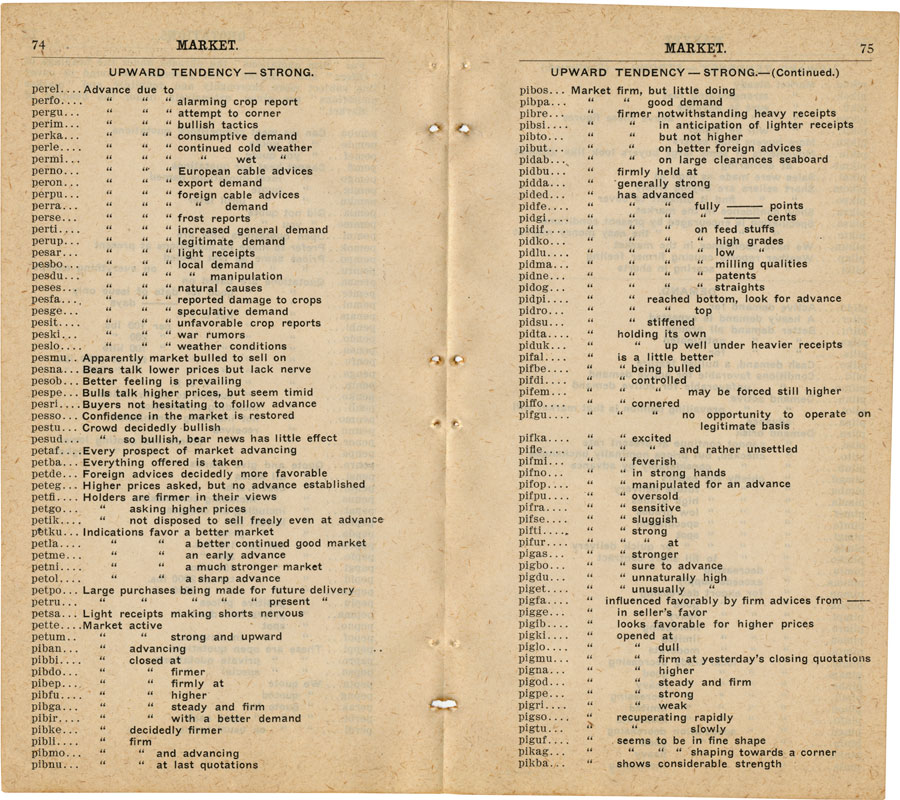 |
|
| market tendencies | |
Lovely dadaistic/business language pairings here —
petsa pette petum piban, or
pifka / excited, pifti / strong, piget / unusually, piglo / dull.
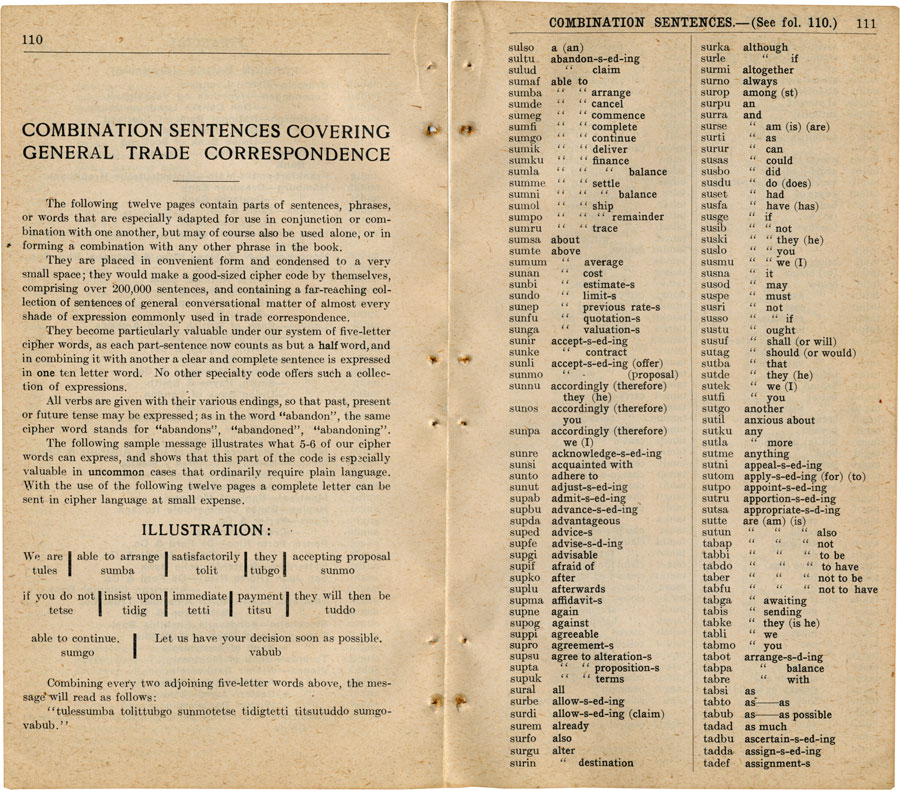 |
|
| pages 110-111 | |
Combination sentences, sometimes referred to as skeleton
or flexible
phrases, enable the sender to assemble a more complete sentence, generally about subjects other than commodity shipments and the like. The illustration provided at the bottom of page 110 comes close to Hugo Ball’s signature effusions (e.g., his Sechs Laut- und Klanggedichte
of 1916, here), just a few years later.
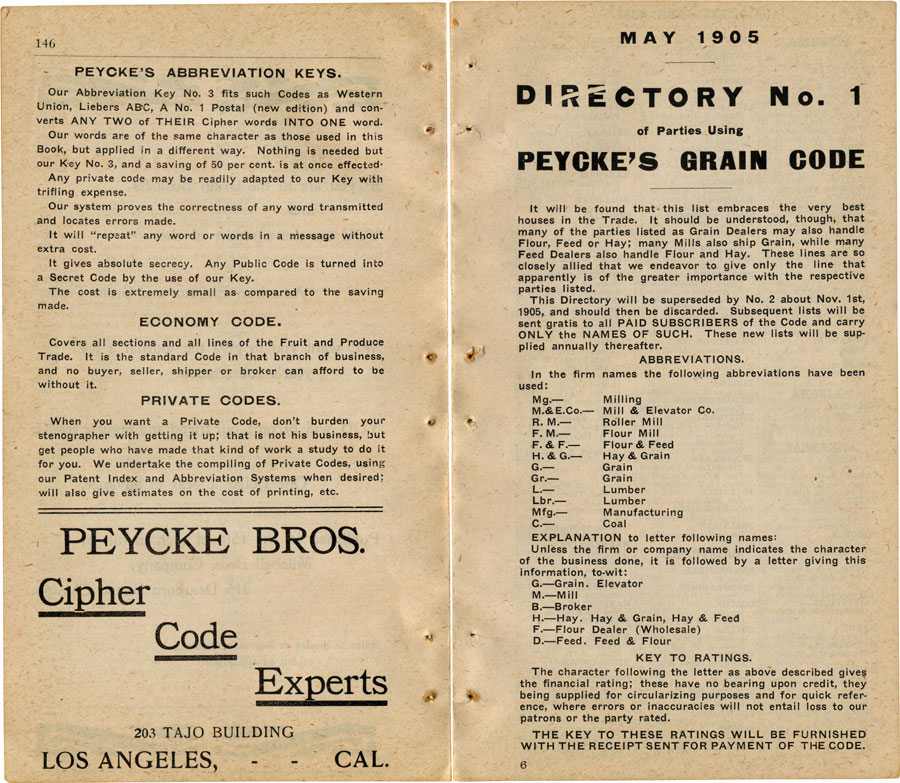 |
|
pages 146, and (unnumbered) start of Directory No. 1(signature 6) |
|
Have not seen Abbreviation Key No. 3, a copy of which is held in BL. It sounds like a condenser, generating one 5L cipher from two (numbered) codewords in the Western Union or other (named) codes. There exists no Liebers ABC
code, the passage was hastily written and not proofread.
I have found no Peycke patent for the abbreviation system.
Under the heading Private Codes
we find the interesting observation that it is not the stenographer’s business to get one up (and yet many codes must surely have started that way). The Directory that is introduced at right, is a strange compilation; the key
of typographic symbols gives financial ratings, and yet these have no bearing upon credit.
So what are they? So purchasers of the code receive a better rating than non purchasers?
| 1906 | Peycke’s telegraphic and cable short-hand cipher code | general | Edmund Peycke Los Angeles | 2 copies recd. [at LC] June 7, 1906 |
I have not examined this code, which is listed in copyright entries, LC. It is described as being similar
to the General Conversation
section in the Modern Economy Code of 1908.
36 p. octavo.
| 1908 | The Modern Economy Telegraphic and Cable Cipher Code
Adapted to the Use of Buyers, Sellers, Brokers, Shippers and Receivers of Green and Dried Fruit and Produce | general | Edmund Peycke Los Angeles | google (NYPL) |
Color scans below from copy in private collection. The NYPL copy available via Google Books is a (February) 1914 reprint, on evidence of an Addenda
covering all Refrigerator Cars added to Equipment of Railroads and Car Lines since the issue of the Modern Economy Code in 1908.
The addenda continues earlier pagination, and runs pp 247-254. Page facing title has been stamped American Code Company;
obverse of title page omits name of printer (The Segnogram Press) that had appeared in 1908 edition. Cannot tell from scan what color original is; 1908 version was printed on blue paper.
The Segnogram Press, Catalogue Printers, Los Angeles, California
[2] iii-x, 1-246
Five-letter code, generally one-letter difference. I believe that the word modern
in the title draws attention to the 5L nature of the codewords.
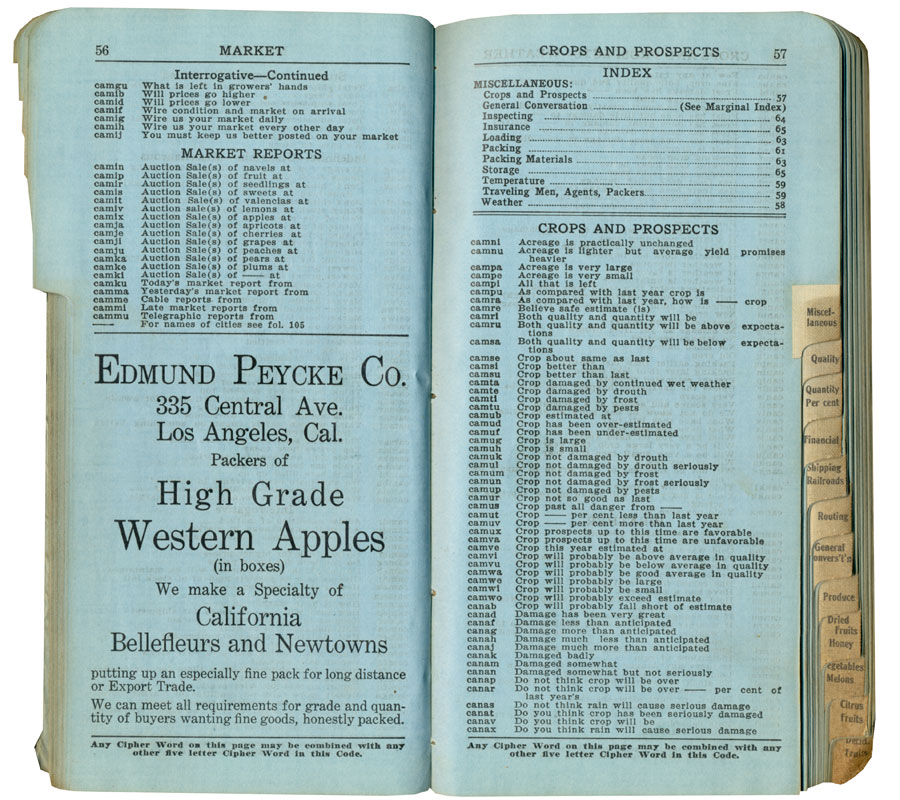 |
|
pp56-57, showing marginal index,the surindexat top of page 57, and the abitrary(code) and varietywords (phrases) thereunder. |
|
Peycke’s 1905 patent (no. 791,209) was for this arrangement.
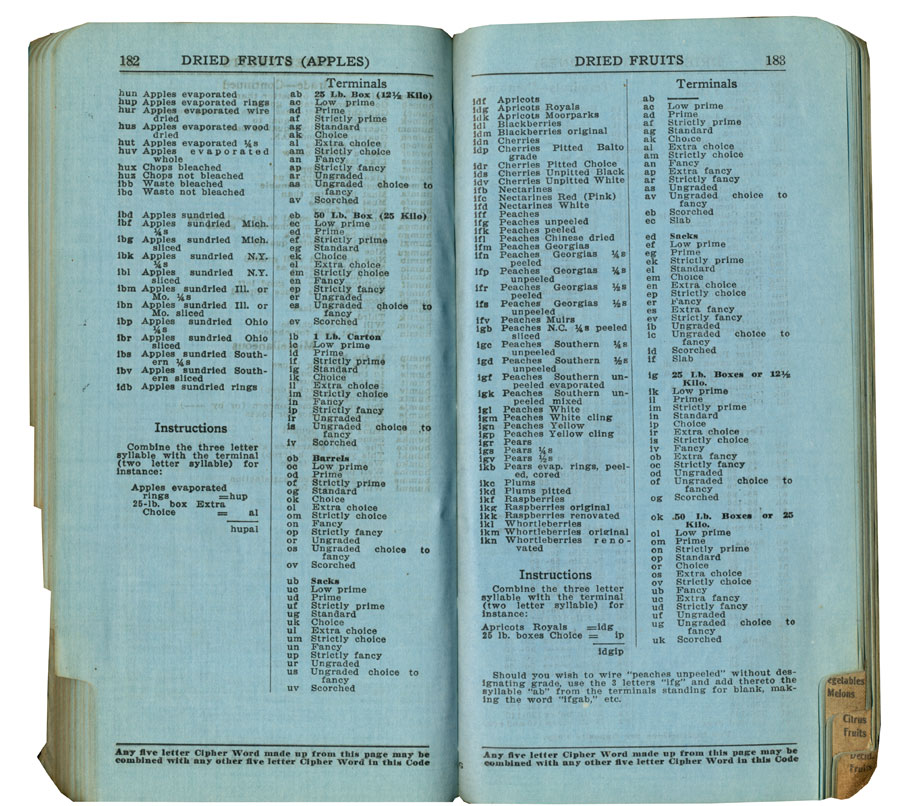 |
|
pp186-87, showing the Peycke abbreviation system. |
|
The Peycke abbreviation system
is not original to Peycke. It abbreviates space in printed codes, and has the advantage of affording a panoptic, one or two-page view of the facets (message molecules) for a specific topic (here, apples and other dried fruits).
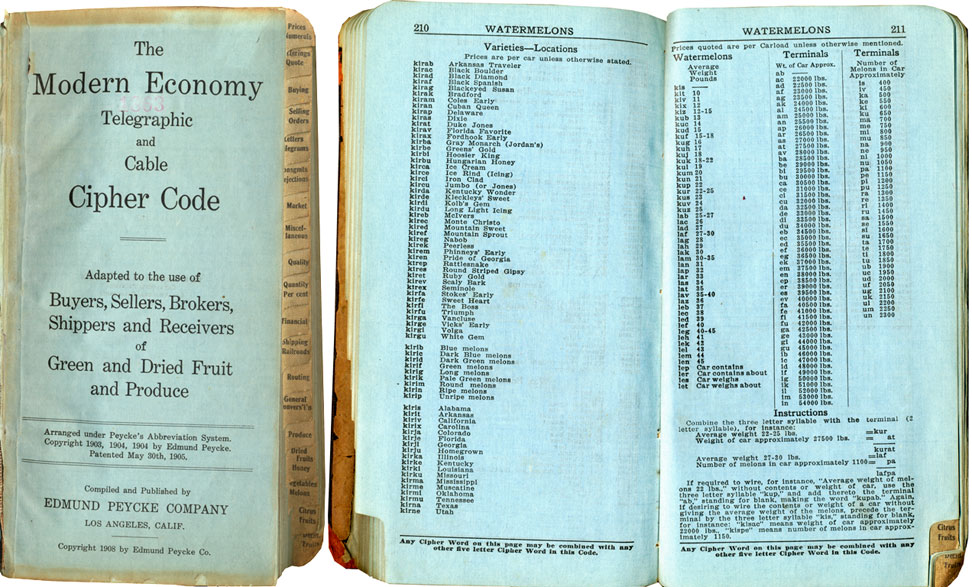 |
|
| apologies for smaller size, from older scan. | |
Cannot help but observe the number of watermelon varieties on offer, when today it’s all seedless!
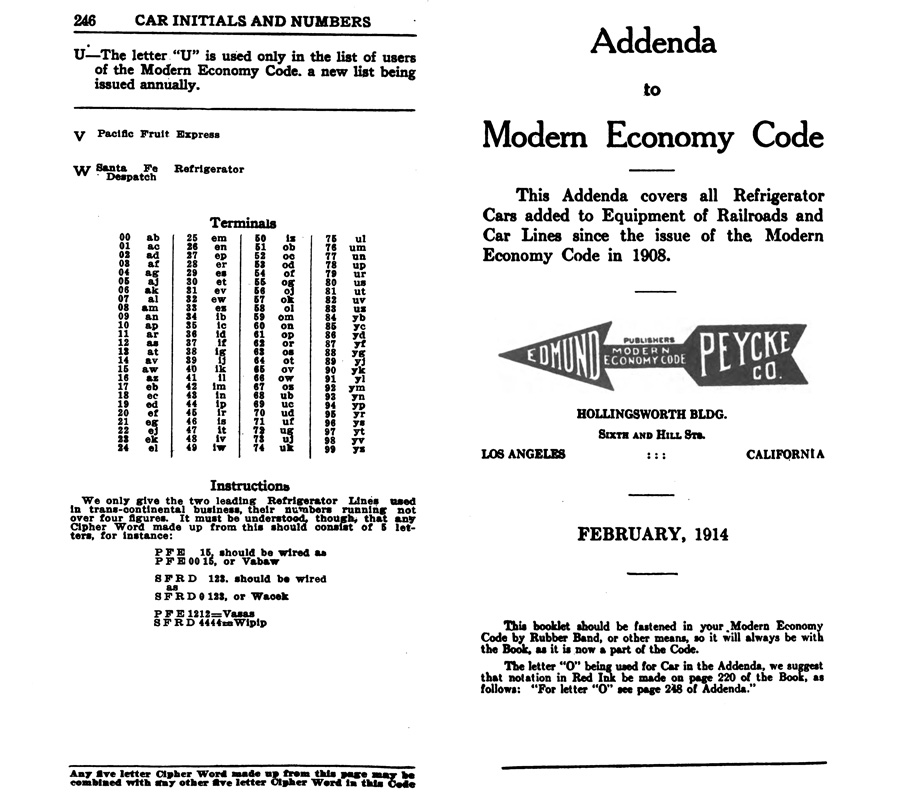 |
||
| p246 from 208 edition, and first page of addenda from 1914 edition (both NYPL/Google Books) | ||
The 3L+2L cypher is, I believe, the Peycke abbreviation system.
| 1918 | Peycke’s New Ekonomik Telegraphic Cipher Code for the Fruit and Produce Trade, Containing Equivalent to 1,310,000 Cipher Words. | general | Edward Peycke, author and publisher; Los Angeles | google (NYPL) |
5L, some 3 + 2 prefix and endings combinations. Indexed, and tabbed.
Unclassifiable phrases and connecting sentences
pp 185-204; Traveling men
pp 204-205; 3+2 Table A for apples and pears pp 231-239; Table B for cranberries/berries 241-243; Table C for deciduous fruits 244-248; grapes 249, &c., &c.; a very few phrases for Avocados at p276.
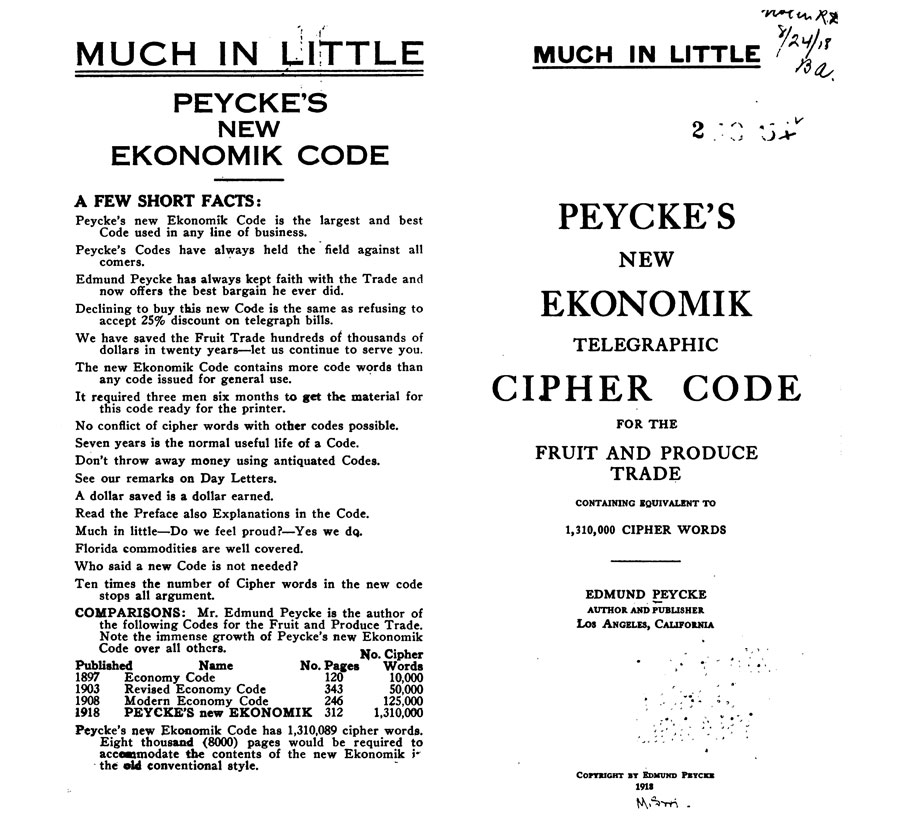 |
|
| back page at left, title at right, cropped. | |
See preceding discussion of the 1900 Economy Code for comments on its possible relationship to an 1897 edition mentioned here.
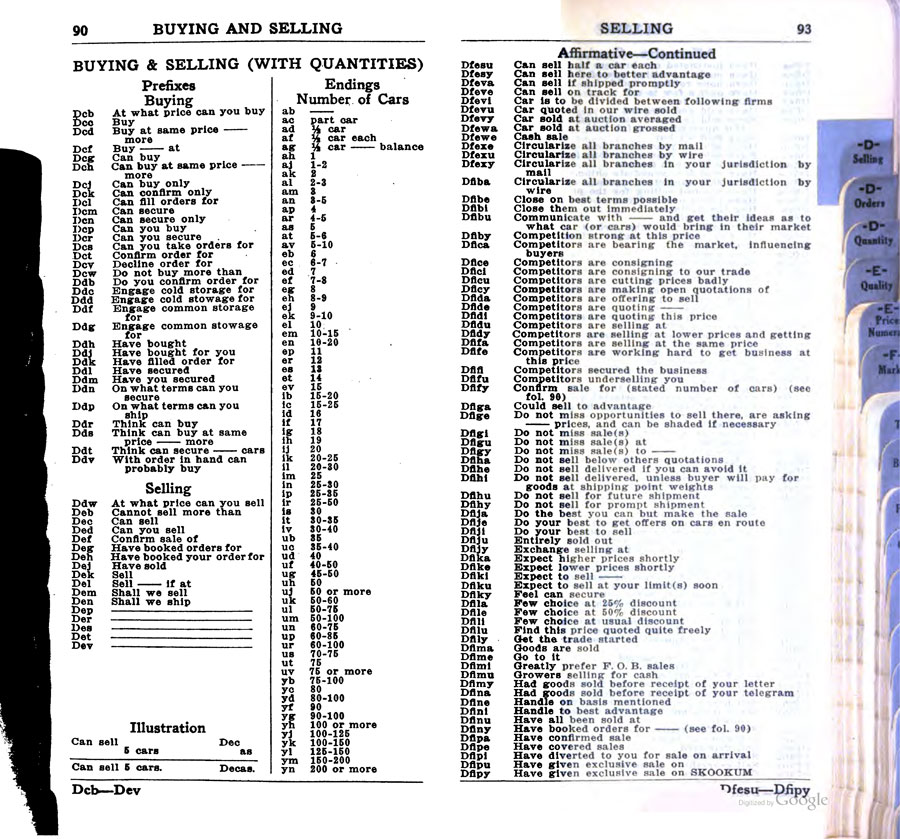 |
|
pages 90, 93 (not spread); including the only page presented in colorin this Google scan. |
|
The 3L prefix plus 2L suffix arrangement at left, continues on for several pages. These are certainly not safe
ciphers.
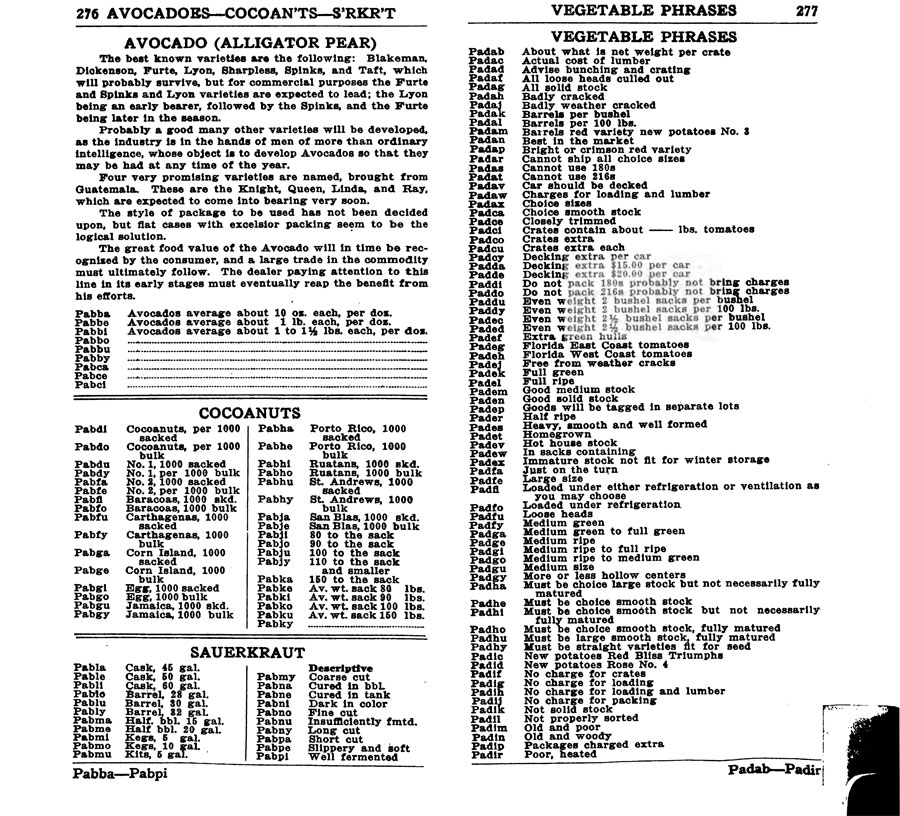 |
|
| cropped, showing tabs at right. | |
Advertisement at end of code includes, among a few short facts,
this —
It required three men six months to get the material for this code ready for print.
The Author of this Code is also the Author of the Economy Code of 1897, Revised Economy Code of 1903, and the Modern Economy Code of 1908. ¶ Ten years ago when the last named Code was compiled it was possible to telegraph ten letter pronounceable words making a certain construction imperative and greatly limiting the number of available words in order to meet the requirements for pronounceability. ¶ A few years later the Telegraph Companies rescinded this privilege substituting a rule limiting the use of made words to groups of letters not over five letters in length wholly disregarding pronounceability. This opened a wide field to the Code compiler, so many more five letter words being available with the former restrictions removed, making the compiling of this book possible, whereas, it could not have been done under previous limitations. ¶ We claim this book to be the largest Code in existence, and the most efficient Code ever issued in any line of business. Several of our tables, notably the
Apple
Table and the Size
Table contain approximately 400,000 cipher words each. The total number of cipher words contained in this Code is in excess of 1,310,000, and all of these words have one or more vowels with the exception of the Car Numbers
in the Bulletin Table
which have purposely been confined to consonants to distinguish them from the regular code words. ¶ As far as possible we have limited the beginning letter of the Cipher Words to one subject, and the construction of our words will at once allay any fear of confusion with other Codes that might be used in the Trade. ¶ Careful attention has been paid to avoid any undesirable combinations from the telegrapher’s point of view.
patents
1905 791,209 Marginal and Sub Index for Telegraphic Cipher Codes
Peycke was a witness to an earlier patent awarded (?) to Rudolf Dorn, of Omaha, Nebraska —
1882 265,770 Hog-Cholera Remedy
and may (or may not — signature suggests not) be the co-inventor (with Leopold Sonnenchein) of —
1903 731,944 Calculating Machine.
Peycke brand fruit crate labels
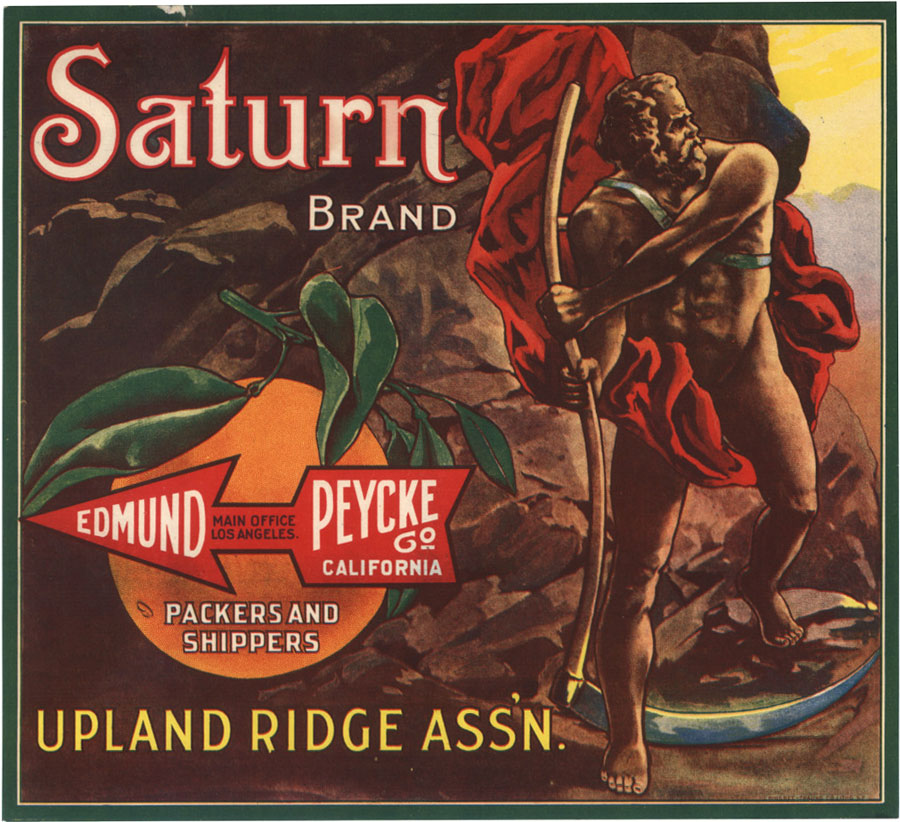 |
|
| This from an eBay vendor. | |
Other Peycke fruit crate labels can be found here and there, including the Huntington Library, shown (poor images) below.
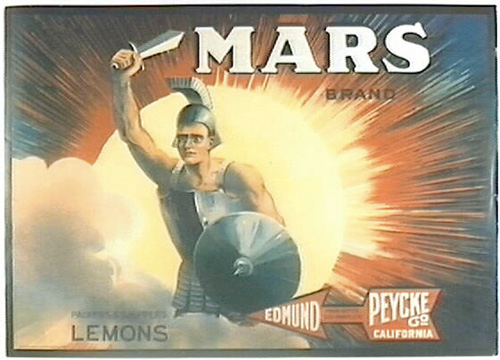 |
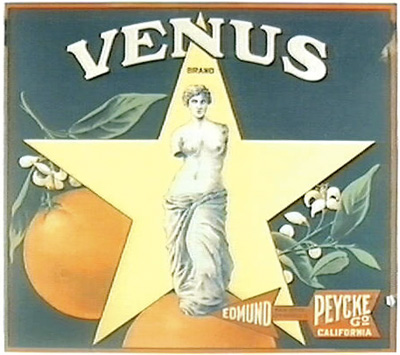 |
| Both images from Jay T. Last Collection of Lithographic and Social History, Huntington Library (here). |
Frieda Peycke, composer-interpreter (1885-1964)
performer and prolific composer of musical melodrama, daughter of Edmund. Papers at Brown (here).
Who’s Who in Music in California (Los Angeles: The Pacific Coast Musician / Colby and Pryibil, Publishers, 1920) — Peycke, Frieda, pianist, recitalist, composer; born in Omaha, Nebraska; educated in Knoxville, California, and Chicago Conservatory of Music. Studied piano with Walton Perkins; harmony and composition with Adolf Weidig; dramatic reading with Gertrude Grosscup Perkins, Bertha Kunz Baker, and later with David Bispham. Taught four years in same school. Specializes as recitalist in her own compositions. Has appeared on numerous occasions in N.C., Pa., Ills., Ia., and other states. Later studied with Fred’k Stevenson. Member Matinee Music Club, Philadelphia, Amer. League Penwomen, Washington, D.C., the S. C. Women’s Press, Lyric and Dominant clubs. Has published a number of songs and choruses and children’s piano pieces. Residence studio, 923 Third avenue, Los Angeles, Cal. (here; portrait at p53))
Kimber (2012) writes: Peycke composed approximately 340 musical recitations, the bulk of which were settings of texts by living poets, some two thirds of whom were women. Recitations formed the largest part of her entire compositional output of approximately four hundred pieces.
(p387) She performed before women’s and other groups, in and beyond Southern California.
See
Marian Wilson Kimber, In a Woman’s Voice: Musical Recitation and the Feminization of American Melodrama,
in Sarah Hibberd, ed., Melodramatic Voices: Understanding Music Drama (Ashgate, 2011): 61-82, especially 76-82, and
Marion Wilson Kimber,
in Allen Scott, ed., Music that speaks—Poems that sing:
the Performance Style of Frieda Peycke,Hands-On
Musicology: Essays in Honor of Jeffery Kite-Powell (Steglein Press, 2012 here): 384-402
Armand H. Peycke, mechanical engineer (1886-1968)
Attended MIT 1909-11*, worked (how long?) at American Steel Foundries in Chicago. An advertisement in back of Peycke’s Grain Code (1905) lists his services as mechanical designing, working drawings, cost estimates, drawings for catalogues, tracings. He may have done some art for the Peycke fruit labels, too.
Married (Dorothy Olga Salone) in Newton, Massachusetts, in 1910. Mrs. Armand H. Peycke seems to have been a supporter of the Opera Benefit and the Student Opera fund, in Chicago, according to the newspaper Wilmette Life in 1939 (here). Armand Peycke died in San Diego.
Numerous patents, all assigned to American Steel Foundries. A partial listing —
1915 1,165,707 Side Frame*
1915 1,140,058 Brake-Head*
1918 1,278,996 Adjustable Brake-Head Means*
1918 1,283,887 Method of Making Forged Fulcrums*
1919 1,295,366 Adjustable Brake-Head Mechanism*
1919 1,295,367 Brake-Head Adjustable Means*
1919 1,299,605 Brake-Head Adjustment*
1919 1,310,032 Brake-Supporting Mecahnism*
1919 1,310,033 Brake-Releasing Means*
1919 1,315,401 Brake Supporting and Releasing Arrangement*
1919 1,315,402 Brake Equipment*
1919 1,323,312 Brake Arrangement*
1919 1,323,315 Equalizer Mechanism*
1919 1,323,313 Brake-Supporting Means*
1919 1,323,314 Brake-Supporting Arrangement*
1919 1,325,533 Release-Spring Clip*
1919 1,325,534 Brake Means*
1920 1,329,009 Brake Mechanism*
1920 1,329,010 Brake Mechanism*
1920 1,335,184 Brake Mechanism*
1920 1,335,185 Release-Spring-Supporting Means*
1920 1,335,187 Brake Supporting and Leveling Device*
1920 1,335,190 Brake Means*
1920 1,335,914 Break-Beam Fulcrum*
1920 1,339,413 Brake-Rigging Arrangement*
1920 1,339,414 Brake Mechanism*
1920 1,339,415 Brake-Rigging*
1920 1,339,416 Brake Supporting and Leveling Device*
1922 1,405,801 Reversible Fulcrum and Method of Making Same*
1936 2,031,127 Brake Head Arrangement*
*Assignor to American Steel Foundries, of Chicago, Illinois
other —
Armand H. Peycke and Robert W. Clyne, Manufacture and Performance of Large Springs,
in Metal Progress 29 (1936): 44-49 — ref; Clyne was a mechanical engineer at American Steel Foundries, author of technical papers and Engineering Opportunities (1939).